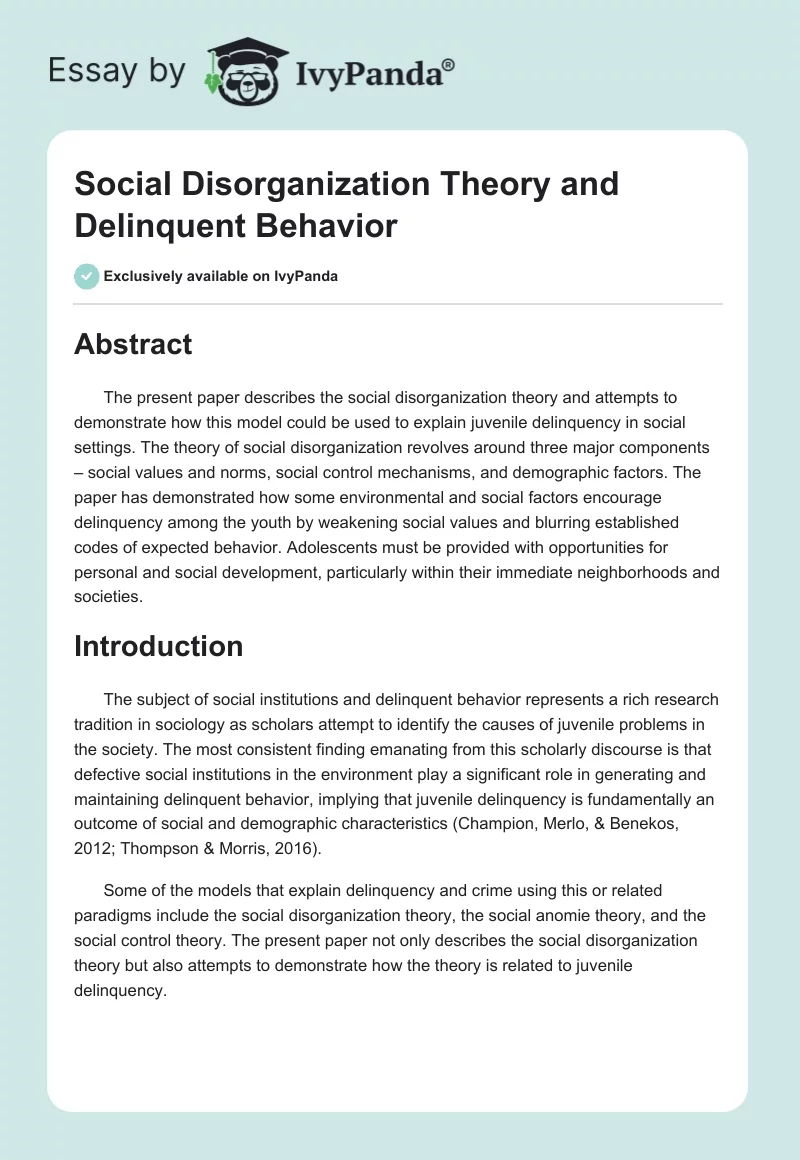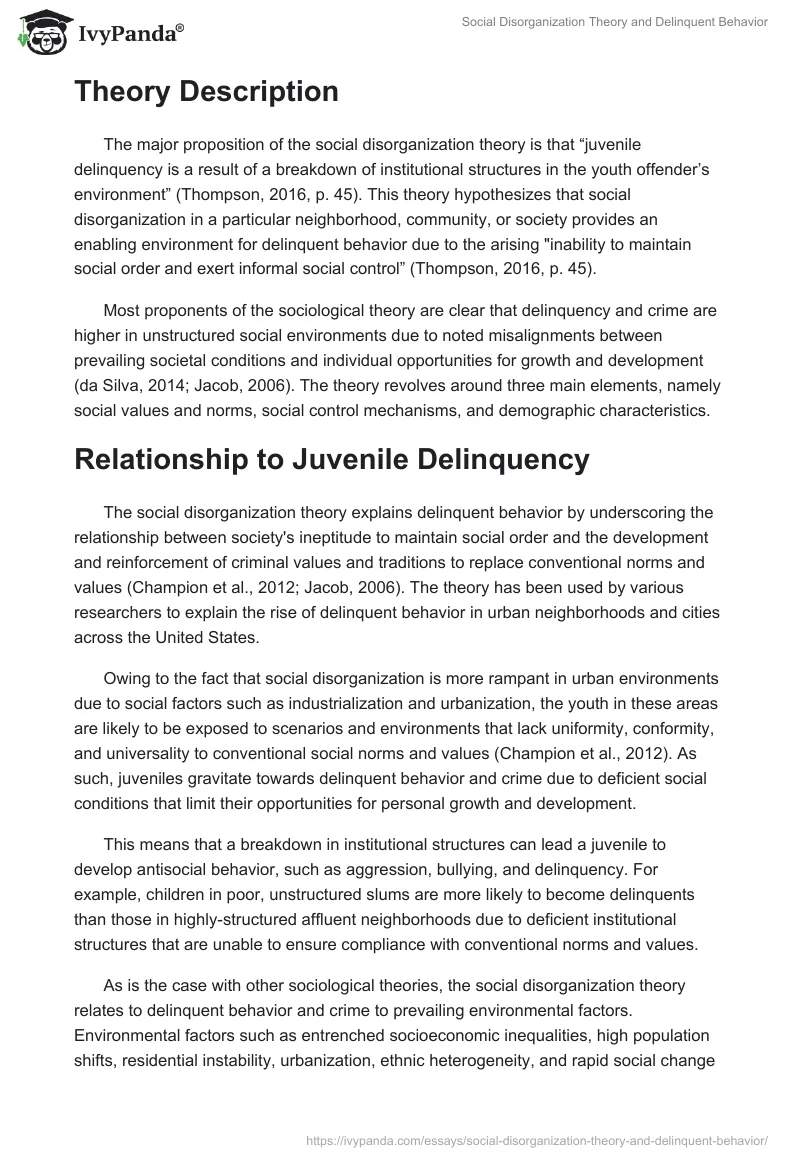Abstract
The present paper describes the social disorganization theory and attempts to demonstrate how this model could be used to explain juvenile delinquency in social settings. The theory of social disorganization revolves around three major components – social values and norms, social control mechanisms, and demographic factors. The paper has demonstrated how some environmental and social factors encourage delinquency among the youth by weakening social values and blurring established codes of expected behavior. Adolescents must be provided with opportunities for personal and social development, particularly within their immediate neighborhoods and societies.
Introduction
The subject of social institutions and delinquent behavior represents a rich research tradition in sociology as scholars attempt to identify the causes of juvenile problems in the society. The most consistent finding emanating from this scholarly discourse is that defective social institutions in the environment play a significant role in generating and maintaining delinquent behavior, implying that juvenile delinquency is fundamentally an outcome of social and demographic characteristics (Champion, Merlo, & Benekos, 2012; Thompson & Morris, 2016).
Some of the models that explain delinquency and crime using this or related paradigms include the social disorganization theory, the social anomie theory, and the social control theory. The present paper not only describes the social disorganization theory but also attempts to demonstrate how the theory is related to juvenile delinquency.
Theory Description
The major proposition of the social disorganization theory is that “juvenile delinquency is a result of a breakdown of institutional structures in the youth offender’s environment” (Thompson, 2016, p. 45). This theory hypothesizes that social disorganization in a particular neighborhood, community, or society provides an enabling environment for delinquent behavior due to the arising “inability to maintain social order and exert informal social control” (Thompson, 2016, p. 45).
Most proponents of the sociological theory are clear that delinquency and crime are higher in unstructured social environments due to noted misalignments between prevailing societal conditions and individual opportunities for growth and development (da Silva, 2014; Jacob, 2006). The theory revolves around three main elements, namely social values and norms, social control mechanisms, and demographic characteristics.
Relationship to Juvenile Delinquency
The social disorganization theory explains delinquent behavior by underscoring the relationship between society’s ineptitude to maintain social order and the development and reinforcement of criminal values and traditions to replace conventional norms and values (Champion et al., 2012; Jacob, 2006). The theory has been used by various researchers to explain the rise of delinquent behavior in urban neighborhoods and cities across the United States.
Owing to the fact that social disorganization is more rampant in urban environments due to social factors such as industrialization and urbanization, the youth in these areas are likely to be exposed to scenarios and environments that lack uniformity, conformity, and universality to conventional social norms and values (Champion et al., 2012). As such, juveniles gravitate towards delinquent behavior and crime due to deficient social conditions that limit their opportunities for personal growth and development.
This means that a breakdown in institutional structures can lead a juvenile to develop antisocial behavior, such as aggression, bullying, and delinquency. For example, children in poor, unstructured slums are more likely to become delinquents than those in highly-structured affluent neighborhoods due to deficient institutional structures that are unable to ensure compliance with conventional norms and values.
As is the case with other sociological theories, the social disorganization theory relates to delinquent behavior and crime to prevailing environmental factors. Environmental factors such as entrenched socioeconomic inequalities, high population shifts, residential instability, urbanization, ethnic heterogeneity, and rapid social change weaken the ability of communities to determine the common norms of their residents and maintain successful social controls (Alanezi, 2010; Rekker et al., 2015).
These issues weaken the ties juveniles have with their neighborhoods and communities, particularly in terms of attachment, commitment, and involvement. Such predisposition coalesces with weak informal social control mechanisms within the community or neighborhood to trigger delinquent behavior. In practical contexts, research is consistent that adolescents who demonstrate weak relationships with their family (no family attachment) and live in unstructured neighborhoods (no social control) are more likely to become delinquents than those who have strong relationships with their families and reside in structured neighborhoods (Alanezi, 2010; da Silva, 2014).
Overall, this discussion shows that demographic characteristics and environmental factors are important in explaining juvenile delinquent behavior through the prism of social disorganization. Some of the demographic/environmental variables that are of importance to the theory include parental marital status, socioeconomic status, residential mobility, and ethnic composition. Consequently, it is important to address these factors by ensuring that the youth are facilitated to grow in favorable social environments that underscore the need to conform to expected forms of behavior.
It is also imperative to provide adolescents with opportunities for personal growth and development in order to encourage positive behaviors that conform to societal expectations. These proposals are bound to improve the environmental and social factors that increase delinquent behavior among juveniles.
Conclusion
This paper has not only described the social disorganization theory but also illustrated how the theory could be used to explain juvenile delinquency in social settings. Overall, it can be concluded that the model is effective in providing a theoretical basis for understanding how environmental and social factors can be used to show why juveniles develop and internalize delinquent behavior. From the analysis, it is evident that some environmental and social factors encourage delinquency among the youth by weakening social values and blurring codes of expected behavior.
References
Alanezi, F. (2010). Juvenile delinquency in Kuwait: Applying social disorganization theory. Digest of Middle East Studies, 19, 68-81. Web.
Champion, D.J., Merlo, A.V., & Benekos, P.J. (2012). The juvenile justice system: Delinquency, processing, and the law (7th ed.). Upper Saddle River, NJ: Prentice Hall.
da Silva, B.F.A. (2014). Social disorganization and crime: Searching for determinants of crime at the community level. Latin American Research Review, 49, 218-230. Web.
Jacob, J.C. (2006). Male and female youth crime in Canadian communities: Assessing the applicability of social disorganization theory. Canadian Journal of Criminology & Criminal Justice, 48, 31-60. Web.
Rekker, R., Pardini, D., Keijsers, L., Branje, S., Lueber, R., & Meeus, W. (2015). Moving in and out of poverty: The within-individual association between socioeconomic status and juvenile delinquency. PLoS ONE, 10(11), 1-17. Web.
Thompson, K.C., & Morris, R.J. (2016). Juvenile delinquency and disability. New York City, NY: Springer.


